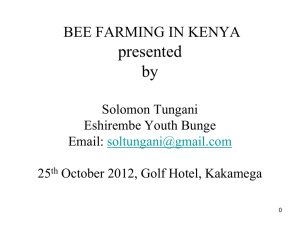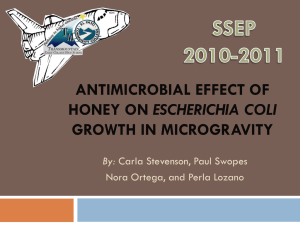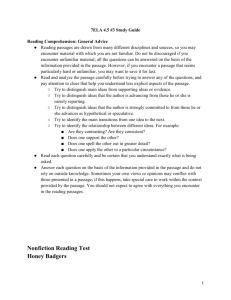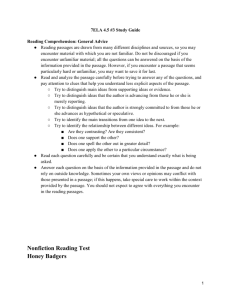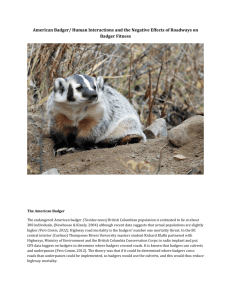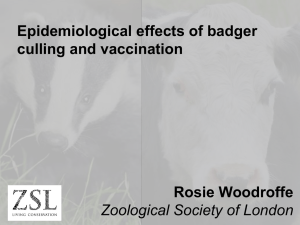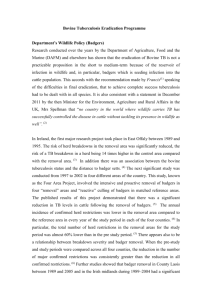The honey badger a.k.a. ratel - ECS Junior High Science Class
advertisement
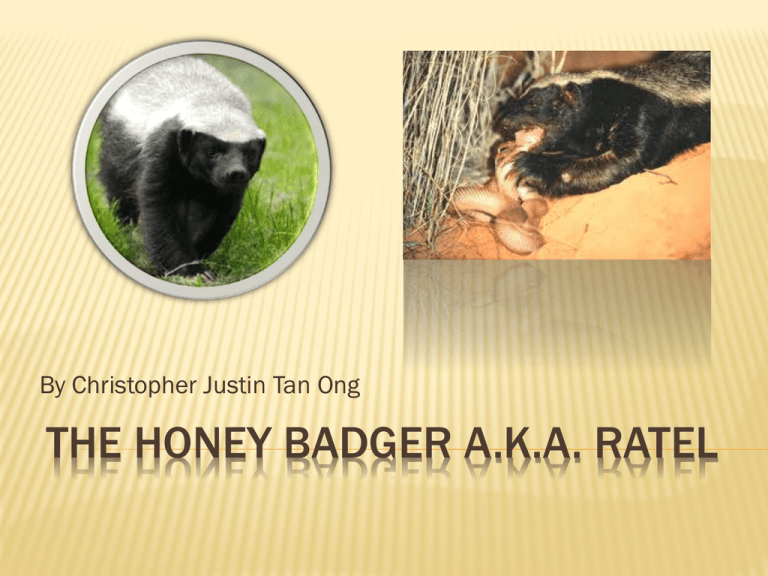
By Christopher Justin Tan Ong THE HONEY BADGER A.K.A. RATEL INTRODUCTION How their names came about….. Honey badgers - love honey and look somewhat like a Eurasian badger. Ratels - Afrikaans word for “rattle” and make a rattle-like noise when growling. CLASSIFICATION Kingdom: Animalia Phylum: Chordata Class: Mammalia Order: Carnivora Family: Mustelidae Subfamily: Mellivorinae Genus: Mellivora Species: capensis Closely related to weasels. Have their own subfamily. Not closely related to badgers. PHYSICAL CHARACTERISTICS White-gray top with black under parts White mantle darkens through age Muscular, sharp long claws, and bushy tail Strong immune system Loose tough skin PHYSICAL CHARACTERISTICS MALE Average male length: 39 inches Average male shoulder height: 15.5 inches Average male weight: 20-31 lbs FEMALE Average female length: 31 inches Average female shoulder height: 14 inches Average female weight;10-22lbs MALE AND FEMALE DIFFERENCES DISTRIBUTION AND HABITAT They can live in almost all conditions. BIG FOOD Large reptiles Large mammals SMALL FOOD Small animals such as bugs and birds Eats fruits, roots, and HONEY! Ratels have sharp strong claws because 80% of its food is from digging. DIET BAD RELATIONSHIPS Attack humans when frightened Raid barns Dig under foundations to eat at livestock Humans kill these creatures with traps, guns, and poison. GOOD RELATIONSHIPS Protected in some countries Reserved by some people HUMAN RELATIONSHIPS CONSERVATION STATUS IUCN least concern Decreasing Main threat is humans Female with cub Female and Male Ratels mate year round. Male home ranges may have thirteen female home ranges in it and may mate with all of them. Babies born in a burrow, blind and naked. Mom has 1-4 babies. REPRODUCTIVE CHARACTERISTICS PARENTAL CARE Male will protect female in estrus but will leave when the baby comes out Mother will change dens frequently 8 month male ratel is as big as the mom. 14 month ratel is let go. LONGEVITY AND MORTALITY Lives 26.4 years in the wild Lives 26.5 years in captivity SEASONAL PATTERNS Nocturnal in the summer Diurnal in the winter. Usually nocturnal if affected by human activity. LONGEVITY, MORTALITY, SEASONAL PATTERNS ASSOCIATIONS Animals follow ratels because 40% of the food it digs goes above ground. Honey guide leads ratel to honey. Ratel eats honey and the bird eats larvae. DEFENSES Farts when hurt. Rips of testicles then goes for everything else. Sometimes attack humans in the same way. ASSOCIATIONS AND DEFENSES FUN EXUBERATING FACTS 1972, a honey badger killed a lion. Top speed 15 mph most fearless animal in Guinness Book of World Records. Skin can stop machetes, some arrows, and some bullets. Skull can ‘lock’. Sometimes the ratel won’t let go until the enemy is dead or itself is dead. Females’ territories sometimes overlap. They pee on the ground to signify their presence. CONCLUSION They can eat almost anything. They have genius defense mechanisms. They’re skin can stop a machete. They can live in all climates. They’re fearless and carefree. Works Cited Firestone, Matthew D., Mary Fitzpatrick, Nana Luckham, Kate Thomas, Luke Hunter, Susan Rhind, and David Andrew. "Honey Badger." Watching Wildlife: Southern Africa ; South Africa, Namibia, Botswana, Zimbabwe, Malawi, Zambia. Footscray, Vic.: Lonely Planet, 2009. 213. Print. Hearst, Michael, and Jelmer Noordeman. "Honey Badger." Unusual Creatures: A Mostly Accurate Account of Some of the Earth's Strangest Animals. San Francisco: Chronicle, 2012. 54-55. Print. "The Honey Badger - Mellivora Capensis." The Honey Badger - Mellivora Capensis. Cool Web Disignz, 2012. Web. 22 Feb. 2013. <http://www.honeybadger.com/>. "Honey Badger (Mellivora Capensis)." Honey Badger Videos, Photos and Facts. Wildscreen, n.d. Web. 22 Feb. 2013. <http://www.arkive.org/honey-badger/mellivora-capensis/>. "Honey Badgers @ National Geographic Magazine." Honey Badgers @ National Geographic Magazine. National Geographic Society, 2005. Web. 22 Feb. 2013. <http://ngm.nationalgeographic.com/ngm/0409/feature6/index.html>. "Mellivora Capensis." Animal Diversity Web. Hiller, 1999. Web. 22 Feb. 2013. <http://animaldiversity.ummz.umich.edu/accounts/Mellivora_capensis//accounts/Mellivora_capensis/>. "Mellivora Capensis." IUCN Redlist. International Union for Conservation of Nature and Natural Resources., n.d. Web. 22 Feb. 2013. <http://www.iucnredlist.org/details/41629/0>. N.d. YouTube. Dir. Navimaru. Perf. Navimaru. YouTube. YouTube, 24 Mar. 2009. Web. 22 Feb. 2013. <http://www.youtube.com/watch?v=wPKlryXwmXk>. YouTube. Dir. Vlogbrothers. Perf. Vlogbrothers. YouTube. YouTube, 30 Nov. 2011. Web. 22 Feb. 2013. <http://www.youtube.com/watch?v=x9Jr9JKpsX8>. THANK YOU TRULY FOR LISTENING TO MY PRESENTATION.
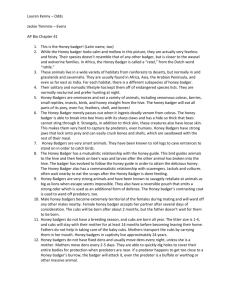
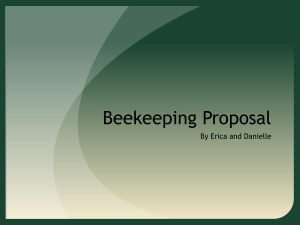

![Jefferson County, KY [Mission 5, Flight Experiment]](http://s2.studylib.net/store/data/005381659_1-6ff410f794c42188c46f63145dca8240-300x300.png)
